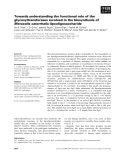
Moraxella infections
-
The glycosyltransferase enzymes (Lgts) responsible for the biosynthesis of the lipooligosaccharide-derived oligosaccharide structures from Moraxella catarrhalishave been investigated. This upper respiratory tract pathogen is responsible for a spectrum of illnesses, including otitis media (middle ear infection) in children, and contributes to exacerbations of chronic obstruct-ive pulmonary disease in elderly patients.
 14p
14p  galaxyss3
galaxyss3
 19-03-2013
19-03-2013
 34
34
 4
4
 Download
Download
-
Harrison's Internal Medicine Chapter 138. Moraxella Infections Moraxella catarrhalis The gram-negative coccus Moraxella catarrhalis is a component of the normal bacterial flora of the upper airways and has been increasingly recognized as a cause of otitis media, sinusitis, and bronchopulmonary infection. Over the past several decades, this organism has been variously designated as Micrococcus catarrhalis, Neisseria catarrhalis, and Branhamella catarrhalis. Bacteriology and Immunity On Gram's staining, M.
 6p
6p  colgate_colgate
colgate_colgate
 21-12-2010
21-12-2010
 94
94
 8
8
 Download
Download
-
Other Syndromes Local extension causing empyema is very uncommon, and—as might be inferred from the low rate of bacteremia—metastatic complications of M. catarrhalis pneumonia, such as septic arthritis, are exceedingly rare. As of 1995, 58 cases of bacteremic infection due to M. catarrhalis had been reported, mainly in children 60 years old; most of these patients had severe underlying lung disease and/or were immunocompromised. The syndromes reported have included bacteremia with no apparent focus, pneumonia, endocarditis, and meningitis.
 5p
5p  colgate_colgate
colgate_colgate
 21-12-2010
21-12-2010
 64
64
 4
4
 Download
Download
-
Other Moraxella Species Other Moraxella species are occasional causes of a wide range of infections, including bronchitis, pneumonia, empyema, endocarditis, meningitis, conjunctivitis, endophthalmitis, urinary tract infection, septic arthritis, and wound infection. In a report on all Moraxella isolates submitted to the Centers for Disease Control and Prevention between 1953 and 1980, certain clinical associations were apparent (Table 138-2). M. osloensis and M.
 6p
6p  colgate_colgate
colgate_colgate
 21-12-2010
21-12-2010
 66
66
 3
3
 Download
Download
CHỦ ĐỀ BẠN MUỐN TÌM
















